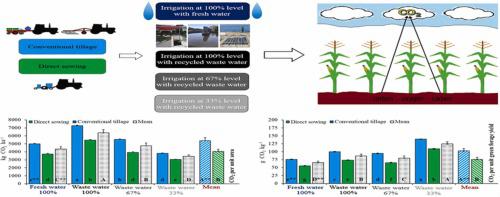Agricultural Water Management ( IF 6.7 ) Pub Date : 2022-06-16 , DOI: 10.1016/j.agwat.2022.107791 Caner Yerli , Ustun Sahin , Taskin Oztas

|
It is necessary to understand and measure the impact of tillage and irrigation practices on CO2 emissions from the soil with an environmental sensitivity, while wastewater irrigation increases crop biomass yield. The main objective of the present study was to investigate the changes and reasons in CO2 emissions from soil conventional and conservative tillage under different levels of wastewater irrigation. The CO2 emission from tillage-sowing to harvest over the regular measurements with a EGM-5 infrared gas analyzer device was investigated with three replicates in three deficit irrigation levels (0%, 33%, and 67%) of domestic recycled wastewater in conventional tillage and direct sowing practices. Binary relationships of CO2 emissions with H2O emission, air temperature, and the soil temperature and moisture measured at three different depths (5 cm, 10 cm, 20 cm) were also investigated and strong (p < 0.01) positive linear correlations were determined. Wastewater irrigation and conventional tillage significantly increased CO2 emissions compared to freshwater irrigation and direct sowing practice, while deficit irrigation practice decreased it. The direct sowing reduced seasonal CO2 emissions 25.1% and 26.1% for per unit area (1 ha) of silage maize and per unit of fresh silage yield (1 kg), respectively, compared to conventional tillage. The lowest CO2 emission per unit area and yield was determined in full irrigation treatment with freshwater in direct-sowing, while, in wastewater applications, it was determined in irrigation levels 33% per unit area and 67% per unit yield, under direct sowing. Thirty-three percent and 67% treatments in direct sowing resulted in less seasonal CO2 emissions as 38.7% per unit area and 13.8% per unit fresh silage yield, respectively compared to full irrigation treatment with freshwater in conventional tillage. Mean CO2 emissions in these treatments were found lower 17.9% per unit area and higher 17.8% per unit fresh silage yield compared to the full irrigation treatment with freshwater in direct-sowing. It was concluded that CO2 emissions per unit yield could be decreased with 33% water saving under wastewater irrigation conditions, and could be achieved environmental additional benefits from more decreasing CO2 emission by direct sowing also.
中文翻译:

直接播种中亏灌条件下青贮玉米土壤CO2排放量
有必要了解和衡量耕作和灌溉做法对具有环境敏感性的土壤 CO 2排放的影响,而废水灌溉可提高作物生物量产量。本研究的主要目的是调查土壤常规耕作和保守耕作在不同废水灌溉水平下CO 2排放的变化和原因。使用 EGM-5 红外气体分析仪装置定期测量从耕种播种到收获的 CO 2排放量,在常规的生活回收废水的三个赤字灌溉水平(0%、33% 和 67%)下进行了三次重复研究。耕作和直播的做法。CO的二元关系还研究了在三个不同深度(5 cm、10 cm、20 cm)测量的H 2 O 排放、气温以及土壤温度和水分的 2 排放,并确定了强(p < 0.01)正线性相关性。与淡水灌溉和直接播种做法相比,废水灌溉和常规耕作显着增加了 CO 2排放,而亏缺灌溉做法则减少了它。与传统耕作相比,直接播种使每单位面积(1 公顷)青贮玉米和每单位新鲜青贮产量(1 kg)的季节性 CO 2 排放量减少5.1 % 和 26.1 %。最低的 CO 2单位面积排放量和产量是在全灌溉处理下用淡水直接播种确定的,而在废水应用中,在灌溉水平上确定单位面积33%和67%的单位面积灌溉水平,在直播下。与传统耕作中使用淡水的全灌溉处理相比,直接播种的 33% 和 67% 处理导致季节性 CO 2排放减少,分别为每单位面积 38.7% 和每单位新鲜青贮饲料产量 13.8%。与直接播种的淡水完全灌溉处理相比,这些处理的平均 CO 2排放量每单位面积降低 17.9%,每单位新鲜青贮饲料产量提高 17.8%。结论是CO 2在废水灌溉条件下,单位产量的排放量可以减少33%,节水33%,并且可以通过直接播种更多地减少CO 2排放来实现环境附加效益。



























 京公网安备 11010802027423号
京公网安备 11010802027423号